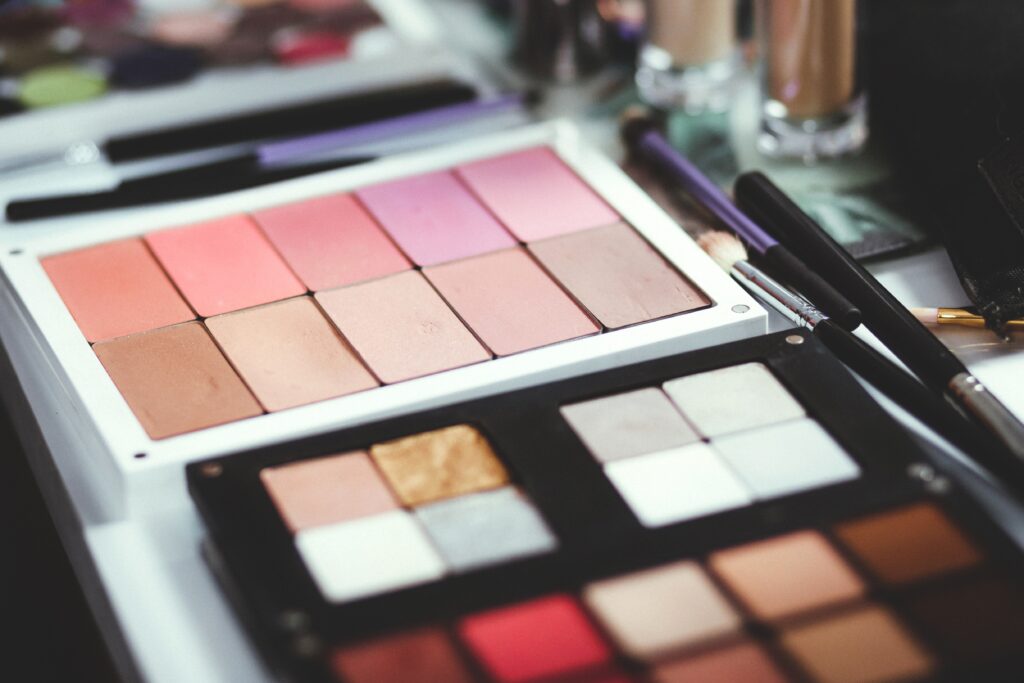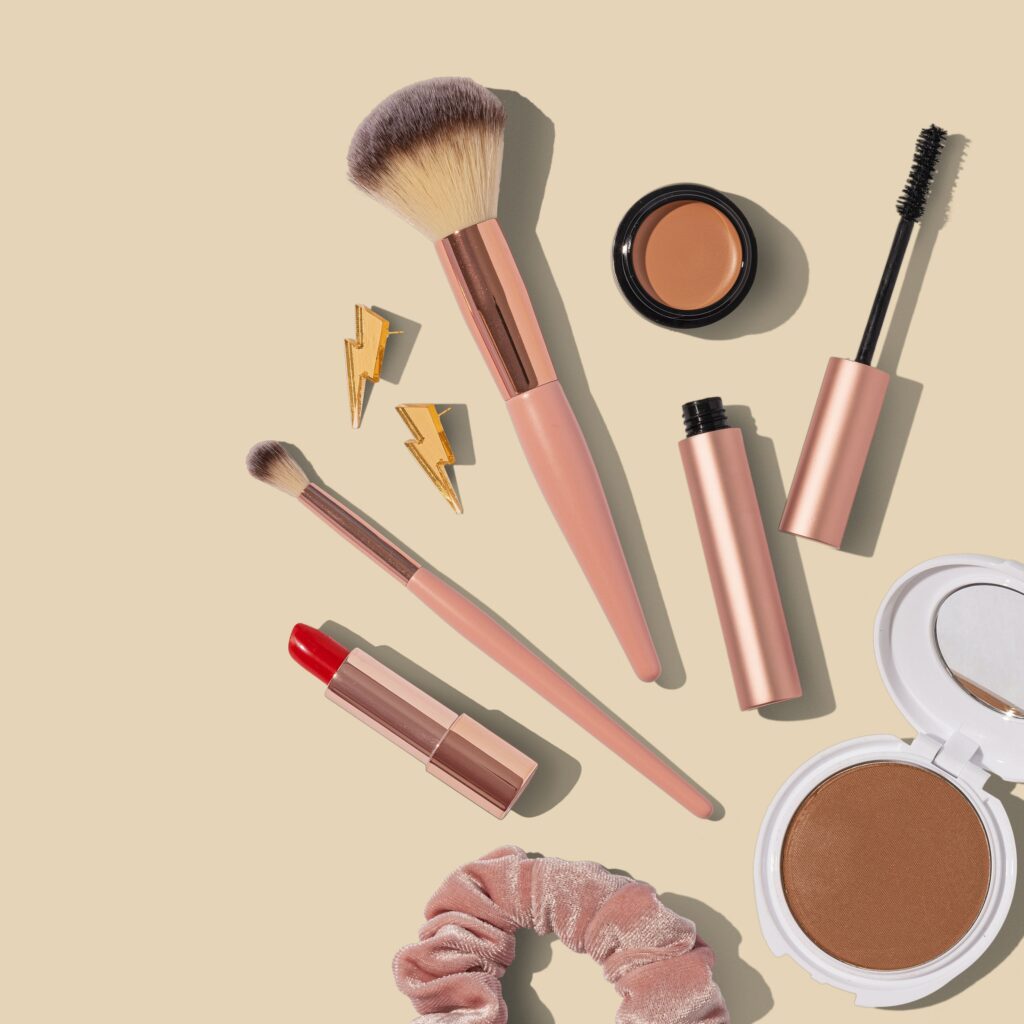Are you curious about the best way to keep your makeup products and tools clean and germ-free? Maintaining proper hygiene when it comes to your cosmetics is essential to avoid skin irritations and infections. In this article, we will guide you through the steps on how to effectively sanitize your makeup products and tools, ensuring that your beauty routine remains both hygienic and safe.

This image is property of images.unsplash.com.
Cleaning Makeup Brushes
Gather necessary supplies
Before you begin cleaning your makeup brushes, it’s important to gather all the necessary supplies. You will need a gentle soap or brush cleanser, a shallow bowl or sink, lukewarm water, and a clean towel or paper towels. It’s also helpful to have a brush cleaning mat or glove, but it’s not essential.
Remove excess product
To start the cleaning process, gently remove any excess product from your makeup brushes. You can do this by swirling the bristles on a clean towel or tissue. This step helps to loosen and remove the caked-on makeup, making the cleaning process more effective.
Wash brushes with soap and water
Once you have removed the excess product, it’s time to wash your brushes with soap and water. Wet the bristles of the brush under lukewarm water and apply a small amount of gentle soap or brush cleanser to your brush or cleaning mat. Gently swirl the brush in the soap to create a lather.
Rinse thoroughly
After lathering the brush, rinse it under lukewarm water until the water runs clear, and all the soap residue is gone. It’s essential to rinse the brushes thoroughly to remove any traces of soap or cleanser, as leftover residue can cause skin irritation when you use the brushes again.
Reshape and dry
To maintain the shape of your brushes, gently reshape them while they are still wet. This step is crucial, especially for fluffy brushes like powder brushes. Once you have reshaped the brushes, lay them flat on a clean towel or paper towel to air dry. Avoid standing the brushes upright during the drying process, as this can cause water to seep into the base of the brush and loosen the glue holding the bristles together.
Deep clean brushes
While regular cleaning is sufficient for most makeup brushes, it is recommended to deep clean them at least once every two to four weeks. Deep cleaning involves using a brush cleanser with added antibacterial properties to thoroughly remove any residual bacteria and product buildup. Follow the same steps as before, but make sure to use a deep cleaning solution specifically formulated for makeup brushes.
Frequency of cleaning
Ideally, you should clean your makeup brushes once a week to maintain their performance and prevent the buildup of bacteria, oils, and old makeup. However, depending on how frequently you use your brushes and the types of products you use, you may need to clean them more or less often. Pay attention to any changes in the brush’s performance or if they start to feel sticky or stiff, as these are signs that it’s time for a cleaning.
Sanitizing Makeup Brushes
Choose a sanitizing solution
Sanitizing your makeup brushes is an essential step in preventing the spread of bacteria and maintaining good hygiene. To sanitize your brushes, choose a suitable sanitizing solution. You can use isopropyl alcohol, specifically formulated brush cleansers with sanitizer properties, or a mixture of antibacterial soap and water.
Spray or soak brushes
Once you have chosen your sanitizing solution, you can either spray it directly onto the bristles of your makeup brushes or soak the brushes in the solution. If you are using a spray, ensure that it reaches all the bristles. If you opt for soaking, place the brushes in a container with enough solution to cover the bristles completely. Allow the brushes to sit in the solution for a few minutes.
Let brushes dry
After sanitizing your brushes, it’s important to let them dry thoroughly before using them again. Place the brushes on a clean towel or paper towels and allow them to air dry completely. Avoid using a hairdryer or other heat sources to speed up the drying process, as this can damage the bristles.
Frequency of sanitizing
Sanitizing your makeup brushes should be done after every use, especially if you are using them on different people or have been using them on a breakout-prone area. Regular sanitization helps to prevent the transfer of bacteria and ensures the brushes remain clean and safe to use. If you are a professional makeup artist or frequently use your brushes on others, sanitize them before each use to maintain optimal hygiene.

This image is property of images.unsplash.com.
Disinfecting Makeup Products
Identify products that can be sanitized
Not all makeup products can be effectively sanitized. However, certain products with powder or solid formulas, such as eyeshadows, blushes, and powders, can be easily disinfected. On the other hand, cream or liquid products, such as foundations, concealers, and lipsticks, cannot be fully sanitized because of their liquid consistency.
Use disposable applicators for certain products
For cream or liquid products that cannot be thoroughly sanitized, it’s best to use disposable applicators, such as cotton swabs, sponge tips, or lip brushes. These applicators can be discarded after each use, preventing any bacteria from spreading and minimizing the risk of contamination.
Spray or wipe down powder products
To disinfect powder products, such as eyeshadows and blushes, you can use a sanitizing spray or wipe. Simply spritz the product or gently wipe the surface with a sanitizing solution containing at least 70% alcohol. This kills any bacteria on the surface of the product.
Wipe down cream or liquid products
As mentioned earlier, cream or liquid products cannot be fully sanitized. However, you can still take steps to minimize bacteria growth on the surface. Using a clean tissue or cotton pad, wipe off the top layer of the product regularly. This helps to remove any buildup of bacteria and keep the product as clean as possible.
Allow products to dry
After sanitizing or wiping down your makeup products, it’s crucial to allow them to dry completely before using them again. Leaving the products open and exposed to the air for a few hours helps to evaporate any moisture and reduces the risk of contamination. Make sure to close the packaging securely after the products have dried.
Frequency of disinfecting
The frequency of disinfecting your makeup products largely depends on personal preference and usage. However, as a general guideline, it is recommended to disinfect powder products every two to three months and wipe down cream or liquid products every one to two weeks. If you notice any changes in smell, texture, or color, it’s best to dispose of the product and replace it with a fresh one.
Cleaning Makeup Sponges
Wet the sponge
To begin cleaning your makeup sponges, start by wetting them under lukewarm water. Make sure the sponge is fully saturated, as this allows the cleansing product to penetrate and remove any makeup residue effectively.
Apply a gentle cleanser
Once the sponge is wet, apply a small amount of gentle cleanser directly onto the sponge or onto your palm. Opt for a cleanser that is specifically formulated for makeup sponges or a mild, fragrance-free soap.
Massage and rinse
Next, massage the cleanser into the sponge using your fingers or a brush cleaning mat. Gently work the cleanser into the sponge, focusing on areas with heavy makeup buildup. Continue massaging until the sponge appears clean and the water runs clear.
Repeat if needed
If your makeup sponge is heavily stained or has stubborn product buildup, you may need to repeat the cleaning process. Simply rinse the sponge under lukewarm water and apply a fresh batch of cleanser. Continue massaging until the sponge is clean.
Squeeze out excess water
After cleaning, squeeze out any excess water from the sponge. Gently press the sponge with your hands or wrap it in a clean towel and squeeze to remove as much water as possible. Avoid twisting or wringing the sponge, as this can damage its shape and structure.
Dry the sponge
To dry the sponge, place it in a well-ventilated area away from direct sunlight. It’s essential to allow the sponge to air dry completely before using it again. Make sure to avoid storing the sponge when it is still damp, as this can lead to the growth of bacteria.
Frequency of cleaning
For everyday use, it’s recommended to clean your makeup sponge after every few uses to prevent the buildup of bacteria, oils, and old makeup. However, if you use your sponge for heavy or full-coverage makeup, it may require more frequent cleaning. Pay attention to any changes in the texture, scent, or performance of the sponge, as these are signs that it’s time for a cleaning.

This image is property of images.unsplash.com.
Sanitizing Makeup Sponges
Mix a sanitizing solution
To sanitize your makeup sponges, you’ll need to create a sanitizing solution. Mix equal parts of water and isopropyl alcohol or hydrogen peroxide in a clean container. The alcohol or hydrogen peroxide helps to kill bacteria and disinfect the sponge.
Soak the sponge
Once you have prepared the sanitizing solution, place the makeup sponge in the mixture, ensuring it is fully submerged. Allow the sponge to soak for at least a few minutes, allowing the sanitizing solution to penetrate and kill any bacteria present.
Rinse thoroughly
After the soaking period, remove the sponge from the sanitizing solution and rinse it thoroughly under lukewarm water. Make sure to squeeze and massage the sponge while rinsing to remove any residual alcohol or hydrogen peroxide.
Squeeze out excess water
Similar to the cleaning process, gently squeeze the sanitized sponge to remove excess water. Press the sponge with your hands or wrap it in a clean towel and squeeze to remove as much water as possible. Avoid twisting or wringing the sponge.
Dry the sponge
To dry the sanitized sponge, place it in a well-ventilated area away from direct sunlight. Allow the sponge to air dry completely before using it again. Remember to avoid storing the sponge when it is still damp to prevent the growth of bacteria.
Frequency of sanitizing
Sanitizing your makeup sponges should be done regularly, especially if you use them on a daily basis or have been using them on different individuals. It is recommended to sanitize your makeup sponges at least once a week. However, if you have acne-prone or sensitive skin, consider sanitizing your sponges after each use to maintain optimal hygiene.
Cleaning Makeup Pencils
Remove any product buildup
Before cleaning your makeup pencils, it’s important to remove any product buildup from the tips. You can do this by gently swiping the tip on a clean tissue or makeup wipe. Removing excess product ensures that the cleaning process is more effective.
Sharpen the pencil
Once the product buildup is removed, sharpen the makeup pencil using a clean and sharp pencil sharpener. Sharpening helps to remove any surface dirt or bacteria and ensures that you have a clean and precise tip for your next use.
Wipe with alcohol or makeup wipes
After sharpening, take a clean tissue or makeup wipe and dampen it with isopropyl alcohol. Gently wipe down the entire exterior surface of the pencil, including the sharpened tip. This helps to sanitize the pencil, removing any remaining bacteria or dirt.
Allow to dry
After wiping the pencil with alcohol, allow it to air dry completely before using it again. This drying period ensures that any remaining alcohol evaporates and the pencil is ready for your next application.
Frequency of cleaning
Cleaning your makeup pencils should be done regularly to prevent the buildup of product, dirt, and bacteria. It’s recommended to clean your makeup pencils every two to four weeks, depending on how frequently you use them. Regular cleaning helps to maintain the performance and cleanliness of the pencil.
Sanitizing Makeup Pencils
Dip the pencil tip in alcohol
To sanitize your makeup pencils, simply dip the tips of the pencils into isopropyl alcohol. Ensure that the entire tip is submerged for a few seconds, allowing the alcohol to penetrate and kill any bacteria present.
Wipe down the pencil
After dipping, take a clean tissue or makeup wipe and wipe down the exterior surface of the pencil, including the tip. Gently rub the entire pencil, ensuring that the alcohol is distributed evenly and any remaining bacteria or dirt is removed.
Allow to dry
Similar to the cleaning process, allow the sanitized pencil to air dry completely before using it again. This drying period ensures that any residual alcohol evaporates, and the pencil is ready for your next application.
Frequency of sanitizing
The frequency of sanitizing your makeup pencils largely depends on personal preference and usage. However, it is generally recommended to sanitize your pencils once every two to four weeks. If you have been using the pencils on different individuals or have acne-prone or sensitive skin, consider sanitizing them before each use for optimal hygiene.
Cleaning Makeup Palettes
Wipe down the palette
To start cleaning your makeup palettes, use a clean and damp cloth or makeup wipe to wipe down the surface of the palette. Gently rub the cloth or wipe over the palette, making sure to remove any excess product or dirt.
Use a gentle cleanser
For tougher stains or residue, apply a small amount of gentle cleanser directly onto the palette. Use a soft brush or sponge to scrub the surface, paying extra attention to any stubborn areas. Be mindful not to use harsh chemicals or abrasive scrubbing tools that can damage the palette.
Scrub with a brush or sponge
After applying the cleanser, gently scrub the palette using a brush or sponge. Ensure that you cover all areas, including the corners and edges. This step helps to remove any leftover product or buildup, leaving your palette clean and ready for future use.
Rinse thoroughly
Once you have finished scrubbing, rinse the palette under lukewarm water to remove any cleanser residue. It’s important to rinse thoroughly to ensure that no leftover cleanser remains on the palette, as this can affect the performance and longevity of the products.
Dry the palette
To dry the palette, gently pat it dry with a clean towel or paper towels. Make sure to remove any excess water to avoid watermarks or damage to the palette’s packaging. Place the palette in a well-ventilated area and allow it to air dry completely before using or storing.
Frequency of cleaning
Regular cleaning of your makeup palettes is crucial to maintain their cleanliness and extend their shelf life. It is recommended to clean your palettes every two to three months, or whenever you notice a considerable buildup of product or dirt. Regular cleaning not only keeps your palettes hygienic but also ensures that the colors remain true and perform optimally.
Sanitizing Makeup Palettes
Spray the palette with alcohol
To sanitize your makeup palettes, use a spray bottle filled with isopropyl alcohol. Spritz the alcohol onto the surface of the palette, ensuring that all areas are covered. The alcohol helps to kill bacteria and disinfect the palette, making it safe and clean for future use.
Wipe down the palette
After spraying the alcohol, take a clean cloth or makeup wipe and gently wipe down the entire surface of the palette. This step further distributes the alcohol and ensures that any bacteria or residue is removed from the palette.
Allow to dry
Allow the sanitized palette to air dry completely before using or storing it. It’s essential to let the alcohol evaporate entirely to prevent any potential skin irritation or product contamination. Ensure the palette is completely dry before closing or using it again.
Frequency of sanitizing
The frequency of sanitizing your makeup palettes largely depends on personal preference and usage. However, it’s recommended to sanitize your palettes every two to three months, especially if you use them on different individuals or when there are noticeable stains or bacteria buildup. Regular sanitization helps to prevent the spread of bacteria and maintain hygiene standards.
Storing Clean Makeup Products
Keep products in a closed case or drawer
After cleaning and sanitizing your makeup products, it’s important to store them appropriately. Store your clean makeup products in a closed case or drawer to protect them from dust, dirt, and exposure to air. This helps to maintain the cleanliness and integrity of the products.
Avoid direct sunlight and moisture
When storing your clean makeup products, ensure that they are kept away from direct sunlight and moisture. Sunlight can degrade the formulas and affect the performance of the products, while moisture can lead to the growth of bacteria or mold. Choose a cool and dry place to store your products.
Use separate containers for each product
To further ensure hygiene and prevent cross-contamination, use separate containers or compartments for each makeup product. This separation minimizes the risk of transferring bacteria or mixing different formulas, preserving the quality of each product.
Keep tools and products covered
When not in use, make sure to keep your makeup tools and products covered. Use caps, lids, or protective covers to prevent dust, dirt, or bacteria from coming into contact with the products. This additional step helps to maintain the cleanliness and longevity of your cosmetics.
Replace packaging if damaged
If the original packaging of your makeup products becomes damaged, cracked, or broken, consider replacing it with a new one. Cracked packaging can allow air, dirt, or bacteria to enter and contaminate the product. Transferring the product to a new, clean container helps to maintain the product’s cleanliness and quality.
Regularly clean storage containers
To maintain a high level of hygiene, regularly clean the storage containers or compartments where you keep your makeup products. Wipe them down with a mild cleanser or disinfecting wipes to remove any accumulated dirt or bacteria. This step ensures that your products are stored in a clean and hygienic environment.
Maintaining hygiene
Properly organizing and maintaining the cleanliness of your makeup products and tools is essential for good hygiene. Regular cleaning, sanitizing, and storage practices help to prevent the buildup of bacteria, maintain product quality, and ensure the safety of your skin. By following these steps, you can enjoy your makeup collection with peace of mind, knowing that you are prioritizing your health and maintaining a high level of hygiene.
